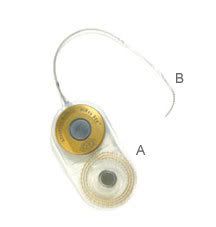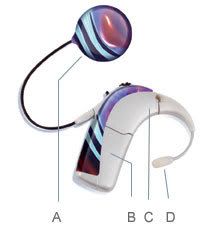The Nitty Gritty: How They Work (VERY LONG)
I have found over the past few months that most people know very little about cochlear implants, some people have never heard of cochlear implants, and some, like my grandma, thought that I was getting a cochlear transplant, as in organ donation (she's since been properly educated and knows more than a lot of folks now :) ). I've been asked many times over the past few days if I'm hearing yet. It doesn't bother me...it seems only logical that an implant to restore hearing would do just that, and people want to hear the good news, and if I didn't know better, I'd ask too :) But, no, I'm not hearing yet. Here's why:
The very process of being implanted destroys any leftover hearing in the implanted ear. The electrode array being pushed through the cochlea damages the tiny hairlike nerve fibers beyond repair. In my case, since I had enough "good" hearing in my "good" right ear to get some benefit from a hearing aid, Dr. Haynes chose to implant my worse left ear, which hasn't heard a sound in 30+ years, so I am not feeling the loss too keenly here...if all goes as planned, I will actually hear "in stereo" for the first time in years....how incredible would THAT be??
Here is what the internal component of the implant looks like (for the record, there are three major manufacturers; I have chosen to go with Advanced Bionics's HiRes90K Implant):

Advanced Bionics' website says that
A -- Implant
The most powerful implant available using state of the art computer technology to deliver electrical signals to the electrode array.
B -- Electrode Array
The only focusing electrodes for targeting the hearing nerves.
Here is a picture, snitched from Dr. Haynes' website, showing how the internal component is positioned:

And then, finally, there is an outer piece, or a processor, shown thusly:

and Advanced Bionics says:
A -- Headpiece
The smallest and lightest headpiece for transmitting to the implant.
B -- PowerCel
Most convenient and cost effective power option.
C -- Processor Module
Powerful processing technology that runs the same sophisticated sound processing software programs as the pager-style processor.
D --Microphone
The only interchangeable input accessory that captures sound in the ear for normal telephone and headphone use.
In a nutshell, here's how it works:
After the internal component is implanted, there is a healing time, usually between 3-6 weeks, and then the big day comes: ACTIVATION DAY! (By the way, the big day will be October 10th, at 9 AM!) On activation day, my audiologist, Susan Amberg, will hook me up with my new processor (which will be silver like the one above, and flashy ;) ). It will attach to my head by an earhook, which will slip on like a hearing aid, and a magnet, which is the circular thingy attached to the coil, above. The implanted part has a metal component that the magnet will attach to. I don't know every single little detail beyond that, but basically, the processor receives the sound, sends it through the coil, through the magnetic connection, through the electrode array, bypassing all those long-lost hearing nerves, straight to the auditory nerve. On Day One, my bewildered auditory nerve, who up until then will have lived a quiet, peaceful life, will be bombarded with a burst of electrical signals. Predictably, the response will be, "Huh?" Most new users don't report a great first day....the brain simply doesn't know what to do with all the new information it's receiving.
Over the next few days, weeks, months, and perhaps even years, the brain gradually begins to make sense of the signals. Most users report that over time, the sounds gradually become more and more natural. Voices go from sounding like beeps and whistles to actually sounding like voices. Crickets and cicadas become annoying. Music finally takes on musical tones. It's a process...usually a long, slow one, but the process varies tremendously from person to person. I can help the process along by listening, listening, listening. The more practice, the better the result. I think I will order Harry Potter on CD. That's something I think I'd enjoy listening to :)
Since I am now essentially part computer (my husband has taken to lovingly calling me his Bionic Woman), my software will need to be updated, tweaked, and generally maintained over the next few months and years. I will see my audiologist every week at first, then less frequently, and she will customize my software just for me, since I will have my own individual likes and dislikes sound-wise.
Do I hear yet? No....but if the Lord wills it, I will...soon :) The adventure is just beginning, folks!
If you're not dead yet from reading, there are updates below. I might keep this near the top for a few days, though, so the latecomers can read up :)
The very process of being implanted destroys any leftover hearing in the implanted ear. The electrode array being pushed through the cochlea damages the tiny hairlike nerve fibers beyond repair. In my case, since I had enough "good" hearing in my "good" right ear to get some benefit from a hearing aid, Dr. Haynes chose to implant my worse left ear, which hasn't heard a sound in 30+ years, so I am not feeling the loss too keenly here...if all goes as planned, I will actually hear "in stereo" for the first time in years....how incredible would THAT be??
Here is what the internal component of the implant looks like (for the record, there are three major manufacturers; I have chosen to go with Advanced Bionics's HiRes90K Implant):

Advanced Bionics' website says that
A -- Implant
The most powerful implant available using state of the art computer technology to deliver electrical signals to the electrode array.
B -- Electrode Array
The only focusing electrodes for targeting the hearing nerves.
Here is a picture, snitched from Dr. Haynes' website, showing how the internal component is positioned:

And then, finally, there is an outer piece, or a processor, shown thusly:

and Advanced Bionics says:
A -- Headpiece
The smallest and lightest headpiece for transmitting to the implant.
B -- PowerCel
Most convenient and cost effective power option.
C -- Processor Module
Powerful processing technology that runs the same sophisticated sound processing software programs as the pager-style processor.
D --Microphone
The only interchangeable input accessory that captures sound in the ear for normal telephone and headphone use.
In a nutshell, here's how it works:
After the internal component is implanted, there is a healing time, usually between 3-6 weeks, and then the big day comes: ACTIVATION DAY! (By the way, the big day will be October 10th, at 9 AM!) On activation day, my audiologist, Susan Amberg, will hook me up with my new processor (which will be silver like the one above, and flashy ;) ). It will attach to my head by an earhook, which will slip on like a hearing aid, and a magnet, which is the circular thingy attached to the coil, above. The implanted part has a metal component that the magnet will attach to. I don't know every single little detail beyond that, but basically, the processor receives the sound, sends it through the coil, through the magnetic connection, through the electrode array, bypassing all those long-lost hearing nerves, straight to the auditory nerve. On Day One, my bewildered auditory nerve, who up until then will have lived a quiet, peaceful life, will be bombarded with a burst of electrical signals. Predictably, the response will be, "Huh?" Most new users don't report a great first day....the brain simply doesn't know what to do with all the new information it's receiving.
Over the next few days, weeks, months, and perhaps even years, the brain gradually begins to make sense of the signals. Most users report that over time, the sounds gradually become more and more natural. Voices go from sounding like beeps and whistles to actually sounding like voices. Crickets and cicadas become annoying. Music finally takes on musical tones. It's a process...usually a long, slow one, but the process varies tremendously from person to person. I can help the process along by listening, listening, listening. The more practice, the better the result. I think I will order Harry Potter on CD. That's something I think I'd enjoy listening to :)
Since I am now essentially part computer (my husband has taken to lovingly calling me his Bionic Woman), my software will need to be updated, tweaked, and generally maintained over the next few months and years. I will see my audiologist every week at first, then less frequently, and she will customize my software just for me, since I will have my own individual likes and dislikes sound-wise.
Do I hear yet? No....but if the Lord wills it, I will...soon :) The adventure is just beginning, folks!
If you're not dead yet from reading, there are updates below. I might keep this near the top for a few days, though, so the latecomers can read up :)

Comments